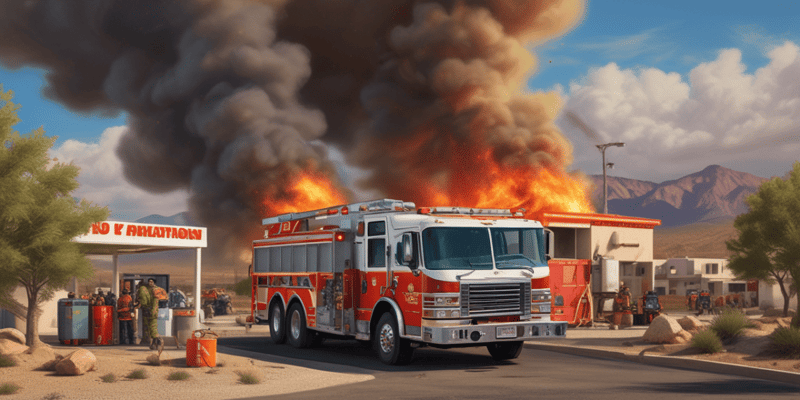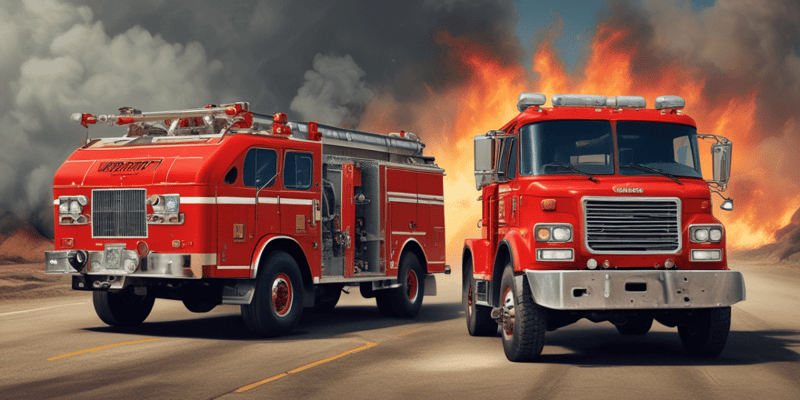Questions and Answers
What should be avoided when a gas leak is in an enclosure or structure?
How should electric PPV fans and smoke ejectors be classified for safety?
What property of natural gas must be considered during an assessment?
What is a common cause of gas leaks in homes?
Signup and view all the answers
What should the Incident Commander consult for determining safe distances in larger incidents?
Signup and view all the answers
What type of ventilation equipment does Hazmat have for use in flammable atmospheres?
Signup and view all the answers
When should the Oklahoma Natural Gas (ONG) company be called?
Signup and view all the answers
What action needs to be taken when using a PPV to vent a house?
Signup and view all the answers
According to the content, what is the best way for the Tulsa Fire Department to judge the amount of product left in a cylinder?
Signup and view all the answers
When choosing a staging and/or attack area for firefighters, where should they set up?
Signup and view all the answers
What is the minimum flow rate required to cool a single cylinder or tank?
Signup and view all the answers
What is the Tulsa Fire Department's recommendation for approaching an exposed and venting cylinder or tank to shut off the fuel?
Signup and view all the answers
Which of the following is true about a natural gas leak with a fire?
Signup and view all the answers
What is the potential hazard associated with incidents involving LPG and other gases stored in cylinders?
Signup and view all the answers
What is the Tulsa Fire Department's recommendation for using unmanned apparatus deck guns/ladder pipes and unmanned master streams when dealing with incidents involving LPG and other gases in cylinders?
Signup and view all the answers
What is the Tulsa Fire Department's recommended strategy when dealing with a leak from a line or cylinder on the exterior of a structure?
Signup and view all the answers
Study Notes
Natural Gas and LPG Response
- Gas leaks are common responses, ranging from a smell of gas in a house to a high-pressure gas main hit by excavation.
Properties of Natural Gas and LPG
- Natural gas is lighter than air and rapidly rises.
- LPG is heavier than air and seeks low areas, like water flowing.
Scene Assessment and Safety Precautions
- When assessing the scene, consider the properties of the product and the size/magnitude of the incident.
- Do not operate light switches, shut off breakers, etc. when a gas leak is in an enclosure/structure.
Evacuation and Shelter-In-Place
- Consider the appropriate evacuation/sheltering measures based on the size/magnitude of the incident.
- Larger incidents require consulting the ERG to determine safe distances.
Locating and Controlling the Source
- Gas leaks in homes often result from faulty appliances and/or faulty installation.
- Shutting off the supply at the valve where the appliance ties into the house piping can often solve the issue.
- ONG should be called to respond to the scene if the leak cannot be found or controlled.
- The IC should consider utilizing Hazmat.
Ventilation
- Venting structures is crucial, especially those with high concentrations of gas.
- When using a PPV to vent a house, it must be initiated from an upwind position.
- Electric PPV fans and smoke ejectors are intrinsically safe.
- Hazmat has ventilation equipment suitable for use in flammable atmospheres if needed.
Vapor Dispersion
- Fog streams may be used to disperse vapors when a leak from a line or cylinder is on the exterior of a structure.
Fire and Explosion Response
Natural Gas
- An exterior fire resulting from a natural gas leak is usually a simple incident.
- Firefighters stand by, protect exposures, and wait for ONG to control the leak.
- A leak with a fire is often considered to be safer than a leak without fire.
- In some cases, firefighters may be able to advance under the protection of fog streams and turn off a supply valve.
LPG and Other Gases in Cylinders
- Incidents involving LPG and other gases stored in cylinders are similar to natural gas incidents.
- The exposed tank/cylinder has the potential to rupture/BLEVE.
- The IC must make a judgment based on the magnitude of the incident, time of fire exposure, and life safety exposure.
- The best ways to judge the amount of product left in a cylinder are TICs and visible cold lines on the cylinder.
- When choosing a staging and/or attack area for firefighters, always set up on the sides of horizontal tanks.
- Do not approach, or set up operations in front of the ends.
- If the IC decides to address the incident, any single cylinder or tank should be cooled with a minimum of 500 gpm.
- Multiple cylinders will require substantially more.
- Consideration should be given to unmanned apparatus deck guns/ladder pipes and unmanned master streams.
- It is a very rare case that firefighters should actually approach an exposed and venting cylinder or tank to shut off the fuel.
Studying That Suits You
Use AI to generate personalized quizzes and flashcards to suit your learning preferences.
Description
This quiz covers the emergency operating guidelines for the Tulsa Fire Department, specifically focusing on natural gas and LPG response, including leaks and properties of these gases.




